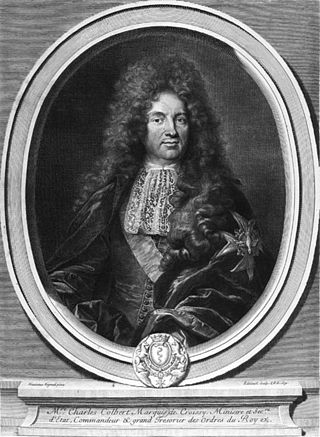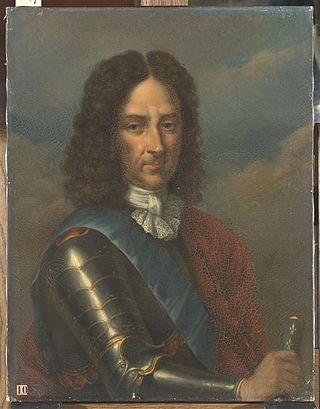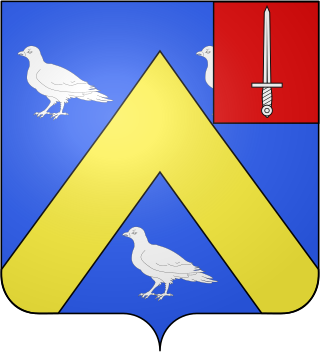
Hombourg-Haut is a commune located in the department of Moselle, region of Grand Est, in the cultural and historical region Lorraine, north-eastern France.

Philibert, Count de Gramont (1621–1707), was a French courtier and soldier, known as the protagonist of the Mémoires written by Anthony Hamilton. He was a younger half-brother of Antoine III of Gramont and uncle of Catherine Charlotte de Gramont, princess of Monaco.

The French nobility was a privileged social class in France from the Middle Ages until its abolition on 23 June 1790 during the French Revolution.

Charles Colbert, Marquis of Croissy was a French statesman and diplomat.

Guy Aldonce de Durfort, 1st Duke of Lorges, Marshal of France, (1630–1702) fought in the Franco-Dutch War mostly on the Rhine under his uncle Marshal Turenne, but in 1673 he was seconded to the Siege of Maastricht. Back on the Rhine, he fought at Entzheim in 1674, at Turckheim in January 1675, and at Sasbach in July 1675, where Turenne fell. He distinguished himself at the retreat from Sasbach and the ensuing Battle of Altenheim.

Eustache de Refuge, seigneur de Précy et de Courcelles, was an Early Modern French courtier, statesman and author.

The Château de Goulaine is a historic château located in the Loire Valley wine region near Nantes, France. The property has been home to the family of the marquis de Goulaine for over a thousand years. The Goulaine name is also used for estate-bottled wine that is produced at the property.

The House of Châtillon was a notable French family, with origins in the 9th century. The name comes from that of Châtillon-sur-Marne in Champagne, where members of the family were tenants in a castle belonging to the Counts of Champagne. Gaucher V of Châtillon was lord of Châtillon from 1290 until 1303, when he became count of Porcien. The title was then sold to Louis of Valois, Duke of Orléans in 1400. Other branches of the family were in Saint-Pol-sur-Ternoise, in Blois, and in Penthièvre.

François Victor Le Tonnelier de Breteuil was a French nobleman. He was minister for war twice under Louis XV. He was also chancelier, garde des sceaux de la Maison de la reine and commander, provost and grandmaster of ceremonies to the Order of the Holy Spirit (1721–1743).
René-Louis Chartier de Lotbinière (1641–1709) was a French-Canadian Poet, 1st Seigneur de Lotbinière in New France (1672), Judge of the Provost and Admiralty Courts and Chief Councillor of the Sovereign Council of New France.

Bernardin Gigault, Marquis de Bellefonds was a French nobleman, military officer and courtier who was appointed Marshal of France in 1668 and held a number of senior positions in the personal household of King Louis XIV.

The invasion of Martinique in 1674 was an unsuccessful attempt by the Dutch Republic to conquer the Caribbean island of Martinique from France. In spite of overwhelming Dutch superiority in men and ships, the French won a decisive and unexpected victory.

Dominique-André Chambarlhac was a military engineer of the French Army during the French Revolutionary Wars and the Napoleonic Wars. Born in Arraye-sur-Seille (Lorraine), he belonged to a family of native nobility of Vivarais.

Conrad von Rosen (1628–1715) was a soldier from Livonia, who served in the French army under Louis XIV from 1646 on. He fought in the Franco-Dutch War (1672–1678) and the Nine Years' War (1688–1691). In 1689 he went to Ireland with James II of England and commanded the Jacobite troops during the final stage of the unsuccessful Siege of Derry.

Jean-Antoine de Mesmes, called d'Avaux (1640–1709), was a French diplomat in the service of Louis XIV. He is probably best known for accompanying King James II of England in his Irish expedition. He also negotiated for France the Peace of Nijmegen, which ended the Franco-Dutch War (1672–1678). He was French ambassador in Venice, The Hague, Stockholm and finally The Hague again.

Etienne Aimé de Ganay, 5th Marquis de Ganay was a French aristocrat and art collector.
Charles François de Boufflers, Marquis de Remiencourt was a French military officer and nobleman.

Claude-Guillaume Testu, Marquis of Balincourt was a French military officer and a marshal of France.

Grovestins' Cavalry Raid was a cavalry expedition in Northern France by a brigade of the Dutch States Army between 10 June 1712 and 28 July 1712 under the command of Major-General Frederik Sirtema van Grovestins during the final stages of the War of the Spanish Succession.
Louis-Charles de Hautefort de Surville, Marquis de Surville was a French nobleman and military officer, and a favourite of Louis XIV.
















